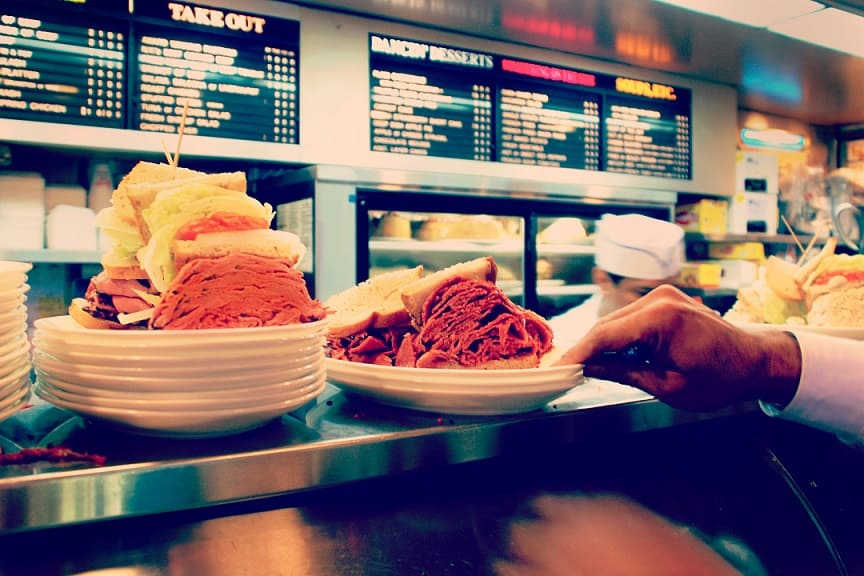The closest cousin in the meat family to pastrami is corned beef. So, you can immediately tell that pastrami and roast beef have vast differences. They come from different cuts of meat and are prepared differently. While they are both made from beef, the result of the preparation of the two is markedly different.
You can go to your grocer, get a fresh shoulder, beef brisket, or sirloin roast, and have it for dinner tonight. However, if you want pastrami, you must buy it already prepared. Otherwise, you will need to devote weeks to prepare it before you can put it on the table for dinner or throw together pastrami on rye, and here is why.
“The main difference between pastrami vs roast beef are as follows:
1. Pastrami is a preserved meat, and roast beef is not.
2. Roast beef can be taken from the cow’s shoulder, hindquarter, neck, belly, and chest area.
3. Pastrami must go through a long preparation process before it is ready to serve. Roast beef, however, can be ready in a few hours.
Let’s look at these differences in more detail!”

How is Pastrami Made?
Pastrami is made from the naval cut of the cow. Its journey to your table begins by first being brined. Brining is the same process that beef, made from brisket, undergoes to become corned beef. The brining process will last a few days to several weeks.
The seasonings used to brine pastrami can include kosher salt, granulated and brown sugars, mustard seed, pickling spices, nitrites and garlic.
After the brining process is complete, the cut of meat is heavily seasoned in preparation for being smoked. At this point, corned beef would go into a pot of hot water filled with peppercorns, allspice, and other herbs, and when finished, it is ready for the table. On the other hand, pastrami will go into a smoker after it is brined. Smoking the brined meat adds a different flavor than corned beef and flavors you will never get from roast beef.
Once the meat for pastrami is removed from the brine, it will get a heavy coat of coarsely ground coriander seeds and peppercorns. At this point, the meat is placed in a smoker for five hours or so. Once removed from the smoker, the meat is chilled in preparation for slicing. Pastrami that is served hot or cold is worth the weeks of waiting required to make this form of culinary delight.
Cuts of beef that are most commonly roasted
Beef brisket is a very versatile cut of meat and, as you can see, is used to make corned beef and can be used to make pastrami in the absence of a naval cut of beef. However, it is also an excellent cut to smoke, barbecue, or roast.
There are many other cuts of meat that make a fantastic beef roast. They include eye of round steak, bottom round steak, rump roast, sirloin tip roast, tri-tip roast, roasted prime rib, and tenderloin. Any of these cuts can be roasted in your oven.
Classic roast beef is usually seasoned with salt, pepper, and garlic. Still, some recipes will take your cooking into new territory if you are willing to try something new. However, classic roasted beef with au jus, mashed potatoes, and green beans is hard to beat any day of the year.
The biggest difference between pastrami vs roast beef is time
As you see, the biggest difference between pastrami and roast beef is how the two types of meat are prepared. Roast beef is used fresh and has many uses. It can be roasted whole and sliced or cut up and used in stews and casseroles. Your options for use in recipes are limited to sandwiches and a few Italian dishes with pastrami.
The preparation time is what makes pastrami expensive. Making it is labor-intensive and requires anywhere from a week to several weeks before you have a product ready to use. Like turning grapes into wine, the lengthy process adds cost to pastrami. In addition, like winemakers, each producer of pastrami has a recipe that is just a little different from the competition. So, for the brave among you, order up a piece of naval beef, and join the competition.
Beef has been roasted around the globe since man first learned that putting fire together with a slab of meat was tasty. Some claim pastrami originated in Romania, while others say its origins go back to the Ottoman Empire. No matter where it came from, the art of curing meat so that it is available when hunting was not possible was a great leap for humankind.
Using salt and herbs to preserve meat can be traced back to the beginning of time. Besides dehydration, it is one of the oldest methods of preservation. The fact that some of these methods of preserving food are no longer necessary due to modern refrigeration. Yet, they are still around because even though meat preservation was the goal when pastrami was created, it has become a favorite sandwich meat in the United States and elsewhere.
Is Pastrami Bad for You?
If you are being health conscious then roast beef is a healthier option than pastrami.
The brining step required to make pastrami introduces a significant amount of salt into the meat which is not present in roast beef. Additionally, part of the pastrami curing step requires the use of nitrites and the long term health effects of consuming large amounts of meats cured with nitrites is under intense scrutiny.